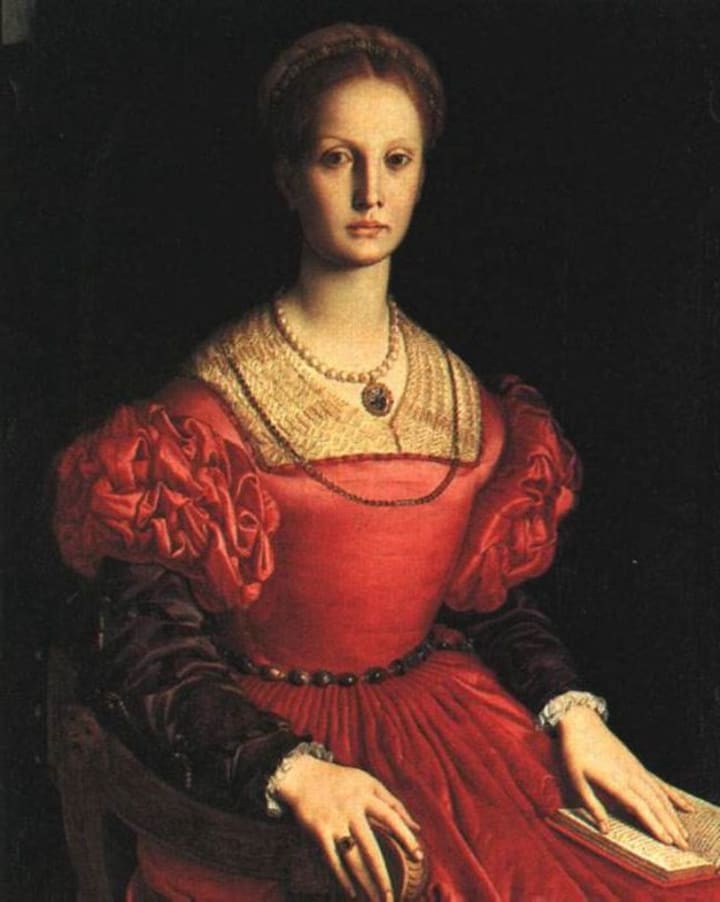
Countess Elizabeth Bathory de Ecsed (1560-1614) was a Hungarian noblewoman and reputed serial killer from the noble family of Bathory, who owned land in the Kingdom of Hungary. She had been labelled by the Guinness World Records as the most prolific female murderer, though the precise number of her victims is debated. Bathory and 4 collaborators were accused of torturing and killing hundreds of young women between 1585 and 1609. The highest number of victims cited during Bathory’s trial was 650. However, this number comes from the claim by a serving girl named Susannah that Jakab Szilvassy, Countess Bathory’s Court official, had seen the figure in one of Bathory’s private books. The book was never revealed and Szilvassy never mentioned it in his testimony. Despite the evidence against Elizabeth, her family’s importance kept her from facing execution. She was imprisoned in 1610 within Cachtice Castle, and immured in a windowless room until her death 4 years later.
The stories of her sadistic serial murders are verified by the testimony of more than 300 witnesses and survivors and the presence of horribly mutilated dead, dying and imprisoned girls found at the time of her arrest. Stories describing her vampiric tendencies (most famously the tale that she bathed in the blood of virgins to retain her youth) were generally recorded years after her death, and are considered unreliable. Her story quickly became part of national folklore, and her infamy persists to this day. She is often compared to Vlad the Impaler of Wallachia (on whom the fictional Count Dracula is partly based); some insist she inspired Bram Stoker’s Dracula (1897), though there is no evidence to support this hypothesis. Nicknames and literary epithets attributed to her include The Blood Countess and Countess Dracula.

EARLY YEARS
Elizabeth Bathory was born on a family estate in Hungarian 1560/1561, and spent her childhood at Ecsed Castle. Her father was Baron George VI Bathory of the Ecsed branch of the family, her mother was Baroness Anna Bathory, who was of the Somlyo branch. Through her mother, Elizabeth was the niece of the Hungarian noble Stephen Bathory, the King of Poland and the Prince of Transylvania. Her older brother was Stephen Bathory, who became a judge royal of Hungary.
During her childhood she suffered multiple seizures that may have been caused by epilepsy, possibly stemming from the inbreeding of her parents. At the time, symptoms relating to epilepsy were diagnosed as the Falling Sickness and treatments included rubbing blood of a non-sufferer on the lips of an epileptic or giving the epileptic a mix of non-sufferer’s blood and piece of skull as their episode ended. This leads to the speculation that Elizabeth’s killing during her later life were part of her efforts to cure the illness she had been suffering from since she was a young child; however, there is no hard evidence supporting the speculation.
As another attempt to explain Elizabeth’s cruelty in her life, many sources say that she was trained by her family to be cruel. Stories include Elizabeth as a child witnessing brutal punishments executed by her family’s officers, and being taught by family members involved with Satanism and witchcraft. Again, there is no hard evidence for these claims.
Elizabeth was raised a Calvinist Protestant. As a young woman, she learned Latin, German, Hungarian and Greek. Born into a privileged family of nobility, Elizabeth was endowed with wealth, education and a stellar social position.
At the age of 13, before her first marriage, Elizabeth allegedly gave birth to a child. The child, said to be fathered by a peasant boy, was supposedly given away to a local woman that was trusted by the Bathory family. The woman was paid for her act, and the child was taken to Wallachia. Evidence of this pregnancy came up long after Elizabeth’s death through rumours spread by peasants; therefore, the validity of the rumour is often disputed.
MARRIED LIFE
Elizabeth was engaged at the age of 10 to Ferenc Nadasdy, in what was probably a political arrangement within the circles of the aristocracy. As Elizabeth’s social standing was higher than her husband’s, she refused to change her last name, and instead Nadasdy assumed the surname Bathory. The couple married when she was 15 and he was 19, at the Palace of Vranov nad Toplou in 1575. Approximately 4,500 guests were invited to the wedding. Elizabeth moved to Nadasdy Castle in Sarvar and spent much time on her own, while her husband studied in Vienna.
Nadasy’s wedding gift to Elizabeth was his household, Cachtice Castle. The Castle had been bought by his mother in 1569 and given to Nadasy, who transferred it to Elizabeth during their nuptials, together with the Cachtice country house and 17 villages.
In 1578, Nadasdy was made the Chief Commander of Hungarian troops, leading them to war. With her husband away at war, Elizabeth Bathory managed business affairs and the estates. That role usually included responsibility for the Hungarian and Slovak people, even providing medical care.
During the Long War (1593-1606), Elizabeth was charged with the defense of her husband’s estates. She was an educated woman who could read and write in 4 languages. There were several instances where she intervened on behalf of destitute women, including a woman whose husband was captured by the Turks and a woman whose daughter was raped and impregnated.
Her daughter Anna, was born in 1585. Her other known children are Orsolya 1590, Katalin 1594, Andras 1516 and Pal 1598. All of Elizabeth’s children were cared for by governesses, as Elizabeth had been.
Elizabeth’s husband died in 1604 at the age of 48. The couple had been married for 29 years. Before dying, Ferenc Nadasdy entrusted his heirs and widow to Gyorgy Thurzo, who would eventually lead the investigation into Elizabeth’s crimes.
ACCUSATION AND INVESTIGATION
Between 1602 and 1604, after rumours of Bathory atrocities had spread through the kingdom, Lutheran minister Istvan Magyari made complaints against her, both publicly and at the Court in Vienna. The Hungarian authorities took some time to respond to Magyari’s complaints. Finally, in 1610, King Matthia II assigned Gyorgy Thurzo, the Palatine of Hungary, to investigate. Thurzo ordered two notaries to collect evidence in March 1610. In 1610 and 1611, the notaries collected testimony from more than 300 witnesses. The trial records include the testimony of the four defendants, as well as 13 witnesses. Priests, noblemen and commoners were questioned. Witnesses included the Castellan and other personnel of Sarvar Castle.
According to the testimonies, Bathory’s initial victims were serving girls aged 10 to 14 years, the daughters of local peasants, many of whom were lured to Cachtice by offers of well-paid work as maids and servants in the Castle. Later, she is said to have begun to kill daughters of the lesser gentry, who were sent to her gynaecium by their parents, to learn courtly etiquette. Abductions were said to have occurred as well. The atrocities described most consistently included severe beatings, burning or mutilation of hands, biting the flesh off the faces, arms and other body parts, freezing or starving to death. The use of needles was also mentioned by the collaborators in court. There were many suspected forms of torture carried out by Elizabeth. According to the Budapest City Archives, the girls were burned with hot tongs and then placed in freezing cold water. They were also covered in honey and live ants. Elizabeth is also suspected of cannibalism.
Some witnesses named relatives who died while at the gynaeceum. Others reported having seen traces of torture on dead bodies, some of which were buried in graveyards, and others in unmarked locations. 2 court officials claimed to have personally witnessed the Countess torture and kill young servant girls. According to the testimony of the defendants, Elizabeth Bathory tortured and killed her victims not only at Cachtice, but also on her properties in Sarvar, Nemetkeresztur, Bratislava and Vienna and elsewhere. In addition to the defendants, several people were named for supplying Elizabeth Bathory with young women, procured either by deception or by force.
It was said that Thurzo went to Cachtice Castle after Christmas on 30th December 1610 and caught Bathory in the act. Thurzo arrested Bathory and four of her servants, who were accused of being her accomplices. Thurzo’s men reportedly found one girl dead and one dying and reported another woman was found wounded while others were locked up. The Countess was put under house arrest.
Although it is commonly believed that Bathory was caught in the act of torture, there is little evidence to support this. Initially, Thurzo made the declaration to Bathory’s guests and village people that he had caught her red-handed. However, she was arrested and detained prior to the discovery or presentation of the victims. It seems most likely that the whole idea of Thurzo discovering Bathory covered in blood has been the embellishment of fictionalized accounts.
It was agreed that Elizabeth Bathory should be kept under strict house arrest and that further punishment should be avoided.
THE TRIAL
Two trials were held in the wake of Bathory’s arrest, the first on 2nd January 1611, and the second on 7th January 1611. Dozens of witnesses and survivors, sometimes up to 35 a day, testified. All but one of the Countess’s servants testifies against her. In addition to the testimony, the court also examined the skeletons and cadaver parts found as evidence.
The exact number of victims is unknown, and even contemporary estimates differ greatly. A servant who spoke at trial as a witness was said to have provided a list more than 650 victims’ names, allegedly in Bathory’s own handwriting. As the number 650 could not be proven, the official count remained at 80. Reportedly, the location of the diaries is known, but 32 letters written by Bathory are stored in the Hungarian state archives in Budapest.

PRISON AND DEATH
Bathory was imprisoned in Cachtice Castle and places in solitary confinement. She was kept bricked in a set of rooms, with only small slits left open for ventilation and the passing of food. She remained immured there for 4 years until her death in 1614.
I'm not sure I find this woman an Inspiration, but she certainly made her mark within the pages of history and has been notorious for hundreds of years, even films have been made about her. An interesting Countess to read about but to me, what really comes across, is that even though Elizabeth Bathory was very high class --- she still was convicted and punished for her crimes --- Justice did prevail ! ! !
Look out for more articles on "Women In History."
About the Creator
Ruth Elizabeth Stiff
I love all things Earthy and Self-Help
History is one of my favourite subjects and I love to write short fiction
Research is so interesting for me too






Comments
There are no comments for this story
Be the first to respond and start the conversation.